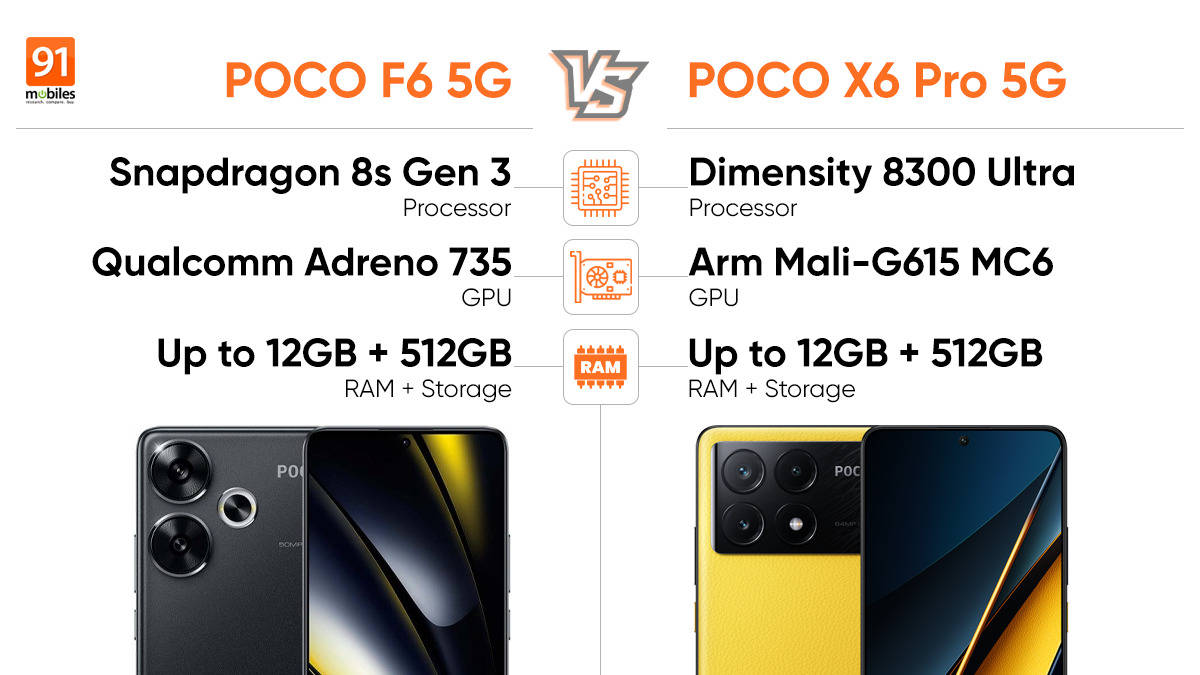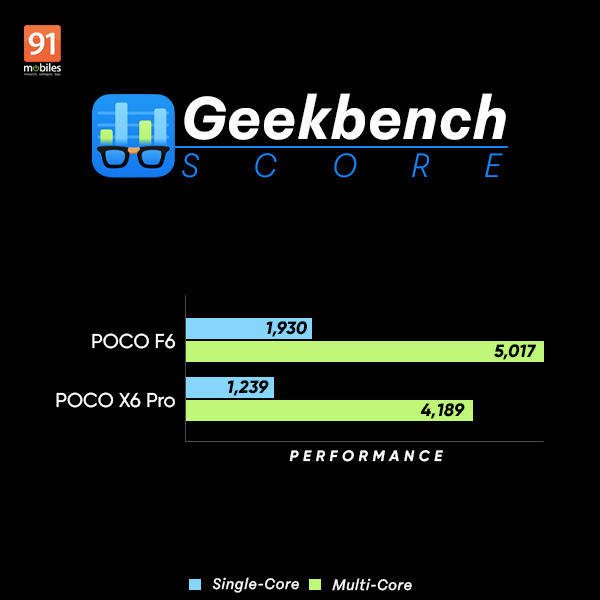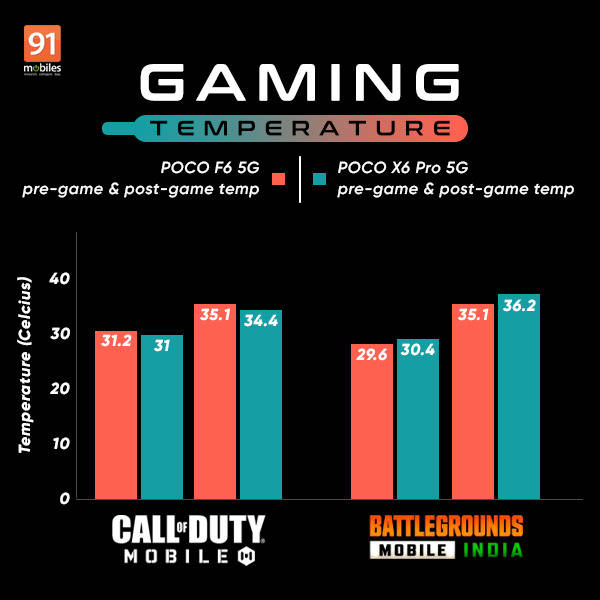
The POCO F6 5G (review) launched in India with much excitement just a few weeks ago. Priced starting at Rs 29,999, it features the latest Snapdragon 8s Gen 3 chipset, up to 12GB of LPDDR5X RAM, and 512GB of UFS 4.0 storage. The POCO X6 Pro (review) also comes with a similar set of hardware, with the exception of a MediaTek Dimensity 8300 Ultra chipset. Let’s compare the two phones and see which POCO phone is a better performer.
Here are the key specifications of both devices:
| Smartphone | POCO F6 5G | POCO X6 Pro 5G |
| Processor | Qualcomm Snapdragon 8s Gen 3 | MediaTek Dimensity 8300 Ultra |
| Graphics | Qualcomm Adreno 735 | Arm Mali-G615 MC6 |
| Memory | Up to 12GB of RAM & 512GB of storage | Up to 12GB of RAM & 512GB of storage |
Table of Contents
Geekbench
The Geekbench benchmark test evaluates the CPU performance of a smartphone. The POCO F6 scored 1930 on the single-core test and 5017 on the multi-core test. In comparison, the POCO X6 Pro registered 1239 on the single-core test and 4189 on the multi-core test. The result suggests that the POCO F6 should offer significantly better performance in both single-core and multi-core based tasks than the POCO X6 Pro.

Winner: POCO F6
AnTuTu
The AnTuTu benchmark test evaluates a smartphone’s comprehensive performance output, including aspects like its CPU performance, GPU performance, Memory performance (RAM + storage), and UX score (user experience score).

The benchmark thus offers a more holistic performance analysis. The POCO F6 registered an aggregate score of 15,09,605, while the POCO X6 Pro registered an aggregate score of 12,99,678. The POCO F6 exceeds the POCO X6 Pro in CPU, Memory performance, and user experience.
Winner: POCO F6
Throttling test
We used the Burnout benchmark test to evaluate the performance output of both devices under throttling. The POCO F6 registered a performance output of 56.6 percent, while the POCO X6 Pro registered a performance output of 70.1 percent under stress. As per the benchmark result, the POCO X6 Pro should offer better performance under extreme stress.

Winner: POCO X6 Pro
Gaming test
For our gaming test, we played some graphically demanding games, including COD: Mobile, BGMI and Real Racing 3, at similar graphical settings and for 30 minutes each. Both phones handle gaming splendidly and support the highest graphical resolution available in each game.

At Very High resolution in COD: Mobile, both phones delivered an average of 60FPS. In Real Racing 3, the POCO X6 delivered better frame rates, averaging around 105FPS, in comparison to the POCO F6’s 58FPS. That is because the game automatically adjusts the graphics as per your device specifications, and the POCO F6’s visual fidelity was higher compared to the POCO X6 Pro. In BGMI, both phones support Ultra HDR resolution and Ultra frame rate settings. The POCO F6 delivered around 54FPS consistently, while the POCO X6 Pro registered around 37FPS.
When it comes to thermals, both phones do a tremendous job of minimising temperatures. The POCO F6’s average temperature rise in three games was about 4.67 degrees C, compared to 5.03 degrees C in the POCO X6 Pro. The POCO F6 wins the gaming test thanks to better gaming performance and temperature management.
Winner: POCO F6
Verdict
The results are clear. The POCO F6 outperforms the POCO X6 Pro in every performance metric, offers a better gaming experience, and is more capable of handling CPU and GPU-intensive tasks. The former is an easy recommendation for anyone who wants the best performance output possible under Rs 30,000.
The POCO X6 Pro offers better stability than the POCO F6. The 12GB+512GB variant of the device costs less than the entry-level POCO F6, and in terms of performance, it is still a great deal for its price. The POCO X6 Pro is an excellent choice if you’re looking to save some money and can compromise a little when it comes to performance.
Smartphones tested by Aditya Pandey & Ujjwal Sharma

![Best battery backup phones under Rs 20,000 in India [July 2024]: Realme Narzo 70 Pro, iQOO Z9, Tecno Pova 6 Pro, and more Related Article](https://www.91-cdn.com/hub/wp-content/uploads/2024/07/Best-battery-backup-phones-under-Rs-20000.png?tr=h-110,q-100,pr-true)




![Fastest charging phones in India under Rs 50,000 [July 2024]: iQOO Neo 9 Pro, OnePlus 12R, Realme GT 6, and more Related Article](https://www.91-cdn.com/hub/wp-content/uploads/2024/07/Fastest-charging-phones-in-India-under-Rs-50000.png?tr=h-110,q-100,pr-true)



![Best camera phones under Rs 20,000 [June 2024]: OnePlus Nord CE 4 Lite, Realme Narzo 70 Pro, POCO X6, and more Related Article](https://www.91-cdn.com/hub/wp-content/uploads/2024/06/Best-camera-phones-under-Rs-20000.png?tr=h-110,q-100,pr-true)

